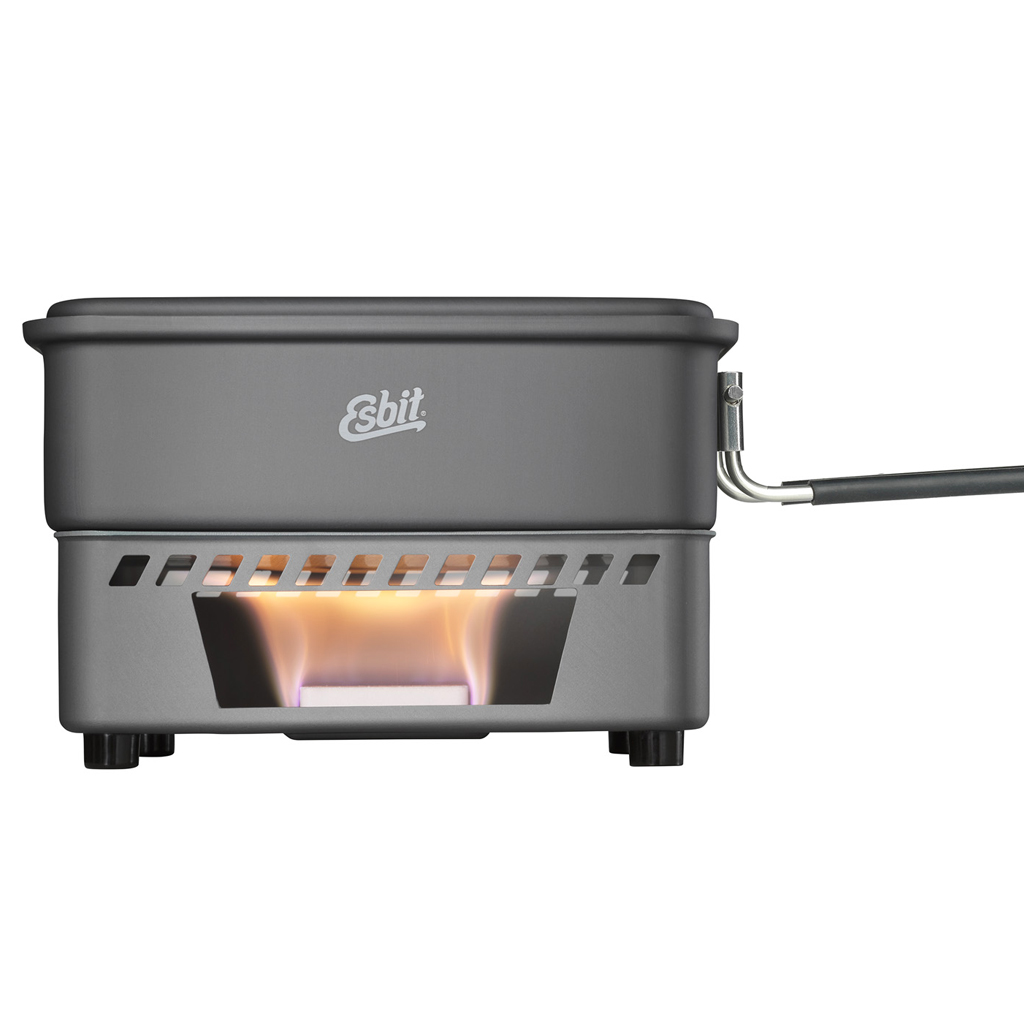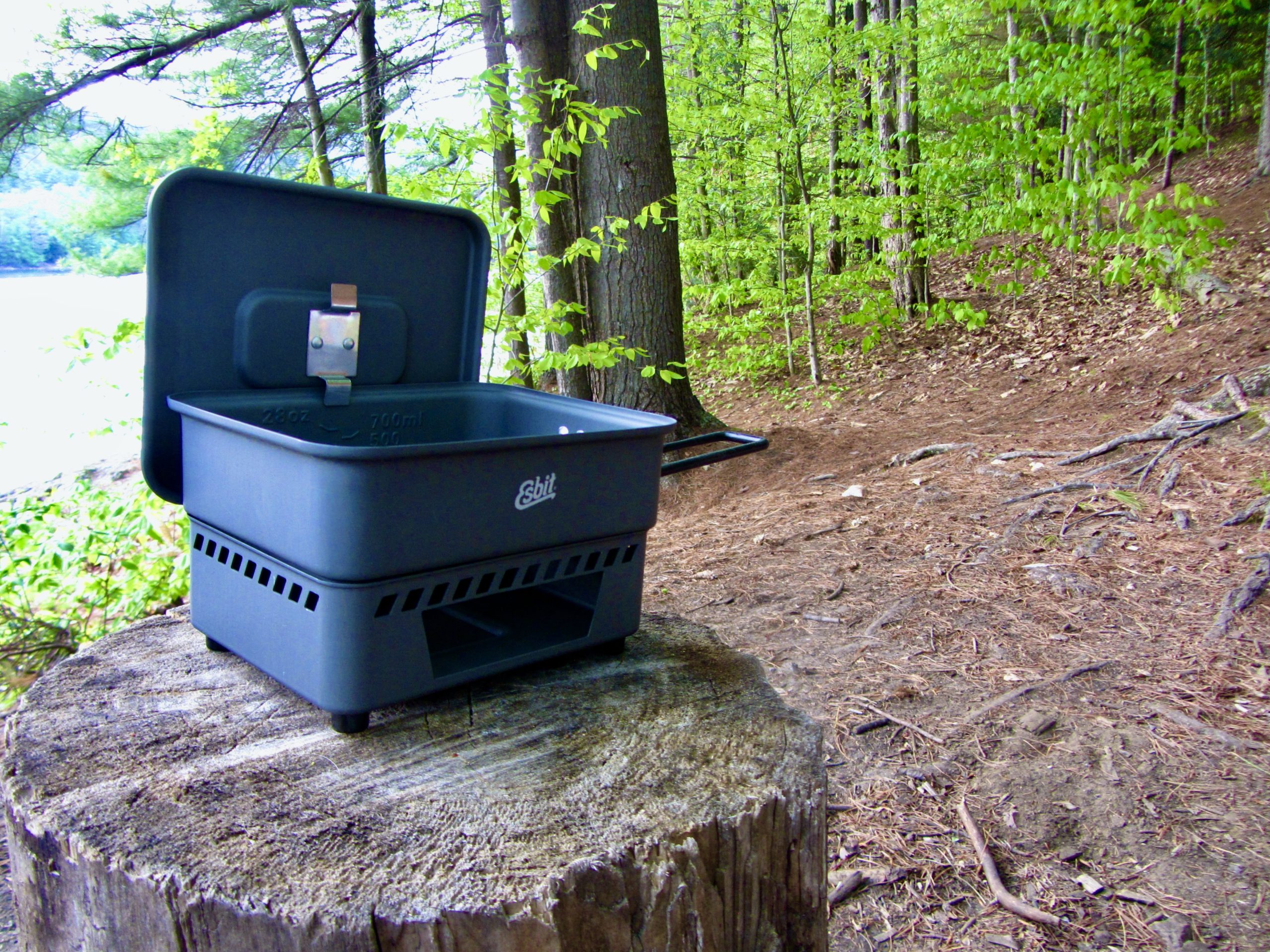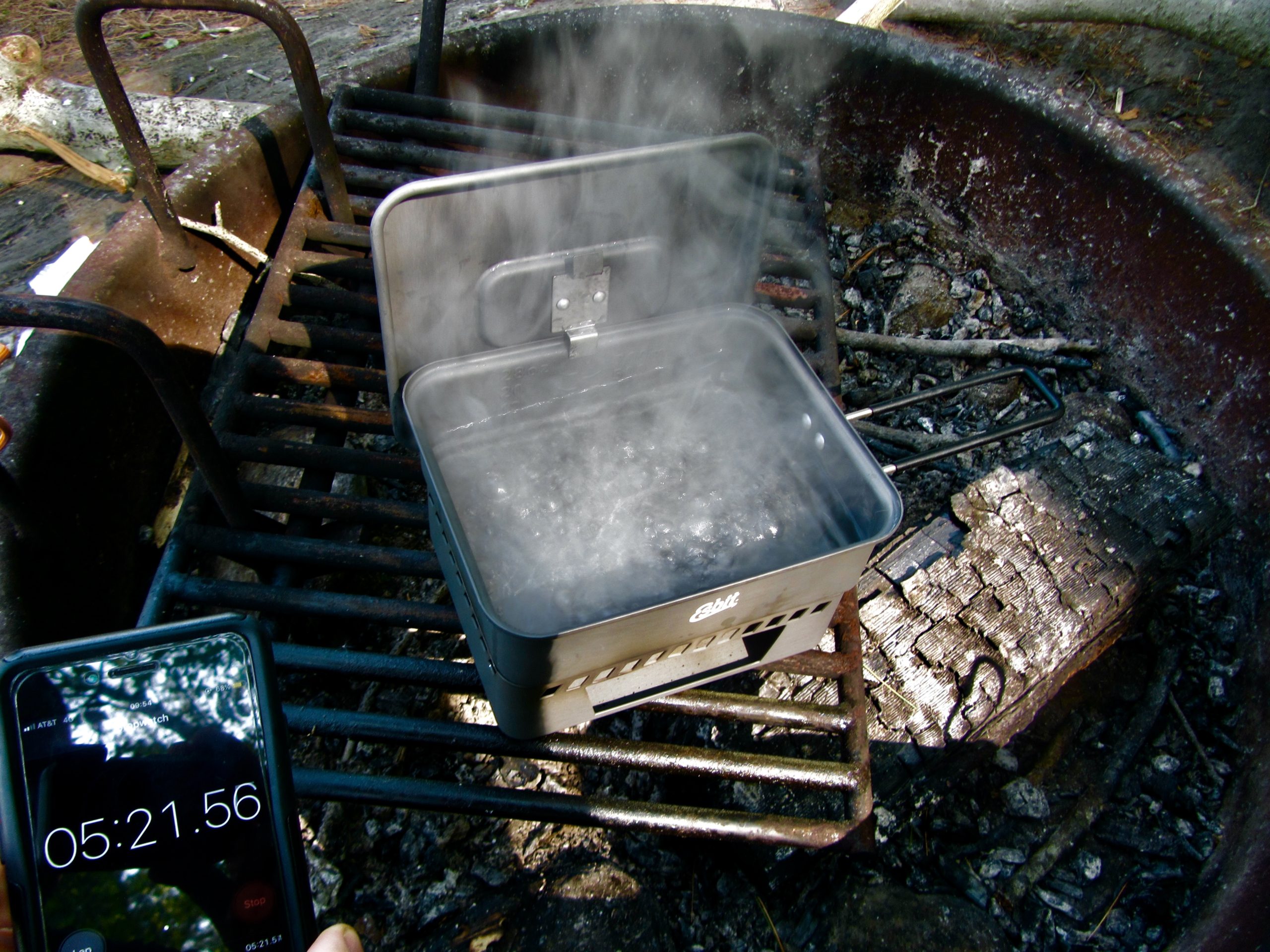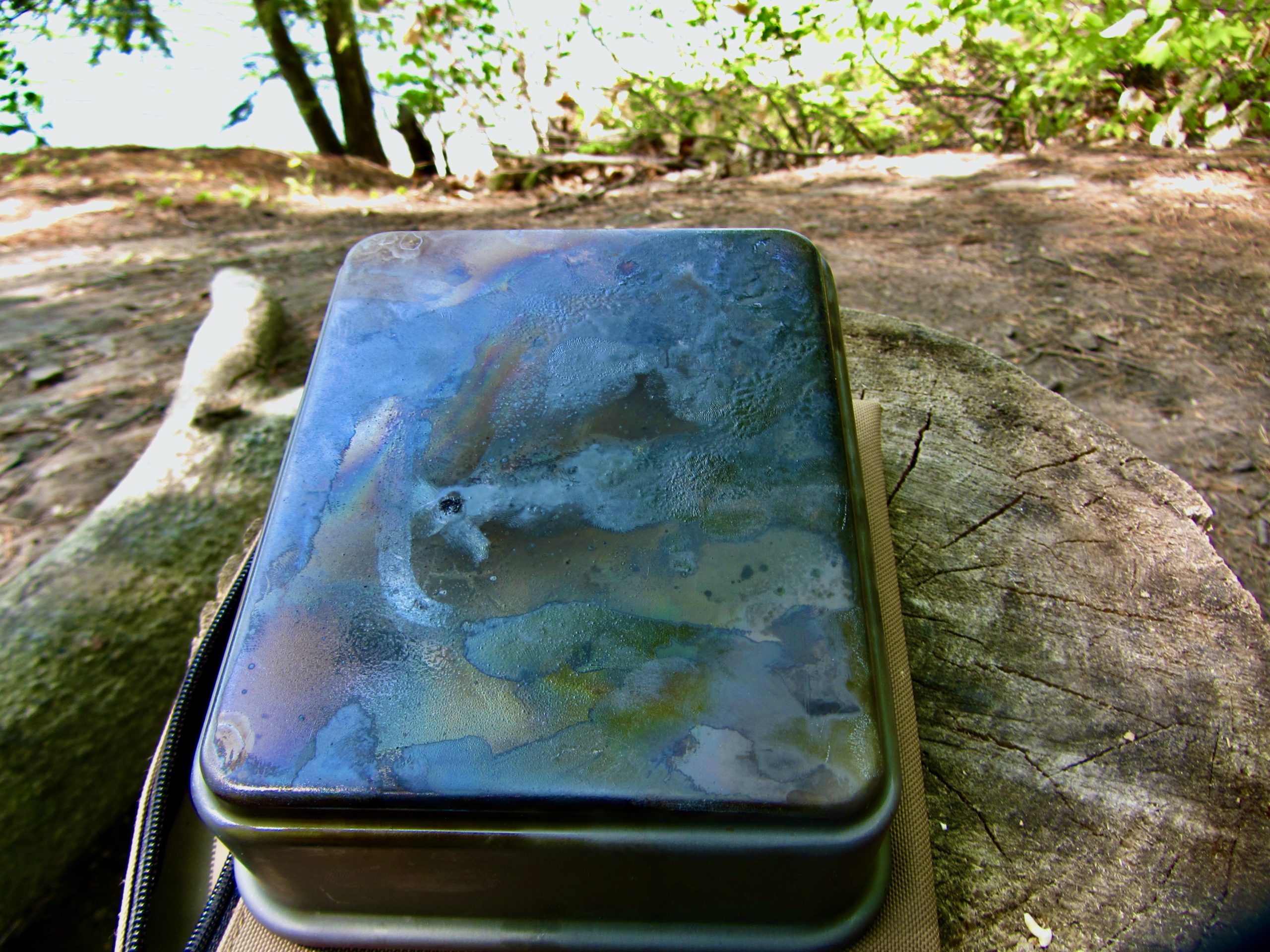Esbit 1100 Solid Fuel Backpacking Stove Review
The end of my backpacking season is usually marked by a bag full of spent fuel canisters. Recycling centers often don’t know what to do with them, most gear outfitters won’t take them back, and I’ve had more than one “no-no” note left on my curbside recycling bin. That’s where solid fuel stoves like the Esbit 1100 come in– no fuel canisters and compact enough for backpacking. In fact, with their 1100 mL model, Esbit went all-in on creating an incredibly compact stove setup that saves on weight and space.
The opportunity to eliminate a fuel canister from my pack and the hassle of properly recycling it afterward grabbed my attention from the very beginning, and I was delighted to give this stove a try.

Esbit 1100 Stove At-a-Glance
- MSRP: $55
- Fuel: Esbit Solid Fuel Tablets
- Boil Time: ~ 5 minutes for 500 milliliters (16.9 ounces)
- Weight: 6.35 ounces | 180grams
- Size: 7.4” x 5.8” x 2.8” | 18.7cm x 14.7cm x 7.2 cm
- Material: Anodized Aluminium
- Components: Pot, Stove, Fuel
Intended Use
The Esbit 1100 is for hikers who want to save weight and space by eliminating a fuel canister from their pack and replacing it with lightweight solid fuel tablets. An ideal candidate for this stove will be using it to boil water for dehydrated meals or for cooking basic dishes – such as pasta. However, be aware that you sacrifice a short boil time in exchange for canister-less cooking.
Circumstances of Review
In early May, a surprise good-weather spell allowed me to take this stove for a spin near the Waterbury Reservoir in Northern Vermont. The conditions were typical New England – a heavily wooded campsite, mild temperatures around 70ºF, and moderately breezy.
Features
Nesting Design: The stove nests perfectly inside the pot. This streamlined design makes the entire setup very easy to pack and transport. There is space leftover inside the stove to store utensils, fuel tablets, a lighter, and any other cooking accouterments you need.
Solid Fuel Tablets: Available in either 27 or 14-gram versions, these tablets burn hot and evenly for a solid cooking experience. For this test, I used the recommended 27-gram tablets.
Graduated Pot: The rectangular pot – designed for packability – includes water level markings in both liters and ounces. Filling the pot to 1100 milliliters (37.2 ounces) will bring the water up to the rim.
Wind-Protected Stove: The burning fuel has wind protection on three sides and a small window on the fourth. This enclosed design is very effective at stopping any wind from interfering with your stove.
Pot Lid Holder: A very handy feature! The pot lid includes a metal tab on the underside, which allows you to rest the lid of the edge of the pot. No more putting the lid on the ground and needing to dust off the dirt and grime.
Lockable Handle: The pot handle locks in the open position for easy cooking and pouring. When hiking, the handle also locks to hold the nested stove and pot together.
Usage In the Field
Setup
So easy! The pot, stove, and fuel are all packed together. All you need to do is open the pot, pull out the stove, set the pot on top, and pop one fuel tablet into the indented area on the stove. Boom – ready to cook.
Lighting
Also very easy. I used a standard Bic lighter, and my method was to lift the pot for easy access to the fuel tablet. I needed to hold the lighter to the fuel for two to three seconds before it lit. Once lit, I never had a problem with the wind snuffing out the flame.
Boiling 500 Milliliters of Water
The Esbit instructions state that this stove can boil 500 milliliters (16.9 ounces) of water in five minutes. I’m pleased to report that this is correct. I started a timer as soon as I started heating the water, and boiling occurred at about five minutes 10 seconds.
Boiling 1000 Milliliters – Test #1
As you’d expect, the boiling time increased dramatically with more water in the pot. We had a hearty ramen and butter combination planned for our first night’s dinner, which required a full pot of boiling water. Under slightly breezy conditions, 1000 milliliters (33.8 ounces) of water took about 16 minutes to boil. This longer boil time required me to throw in another fuel tablet as the first one started to dwindle at about 14 minutes.
But once the water was boiling, it was a pleasure to cook with this stove.
Boiling 1000 Milliliters – Test #2
Our standard breakfast is boiling water poured into bowls of instant oats and a mug of hot chocolate each. Again, we boiled 1000 milliliters (33.8 ounces). This time the boiling process took about 11 minutes and 20 seconds. However, we found that a single pot did not hold enough water for two portions of oatmeal plus two full mugs of hot chocolate (we needed to boil another 300 milliliters). Therefore, I believe Esbit’s claim that this pot is suitable for two people may be slightly stretched.
Cooking
This stove was a pleasure to use for basic cooking. Our pot of ramen for our first night cooked evenly with no burning at the bottom of the pot. The wide rectangular design also offered easy stirring and serving. It’s important to note that Esbit does not recommend this stove for involved cooking. The material itself does not have a non-stick surface, and the fuel’s high heat can easily scorch food cooking directly in the pot. Therefore, my pasta test was sufficient to dip a toe into basic cooking – with great success – while still following Esbit’s guidelines.
Reusing Fuel Tablets
On two occasions, we were done with the stove while the solid fuel was still burning. I easily blew out the flame to see if we could use the fuel later. After several minutes of cooking, the fuel had melted and formed a solid lump on the stove surface. The next morning I tried relighting this fuel lump.
It took much longer to relight – about 15 seconds of holding a flame directly to the fuel – but it did indeed relight and was useable.
Cleaning and Packing Up
By only boiling water and light cooking, this stove required almost no cleaning after use. I noticed that the fuel left a slightly sticky residue on the pot’s underside, but a quick wipe with a cloth took care of it.
Packing up was as easy as plopping the stove back inside the pot, tossing in the fuel and lighter, and sliding the whole contraption back into the mesh bag.
A Closer Look at Solid Fuel Stoves
For many years, gas backpacking stoves have been the mainstay. Either liquid fuel needs to be pumped to the stove – such as the MSR Whisperlite – or isobutane canisters that are screwed directly to your stove for burning. However, a solid fuel tablet eliminates the need for a gas container as you can place the tablet directly onto the stove to heat your pot.
Eliminating the gas canister saves both space and weight while also removing the need to dispose of empty gas canisters after your adventure. The tradeoff is that you lose the concentrated heat that gas canisters provide, and your stove takes longer to boil water.
Esbit 1100 Stove Pros
Packability: Without a bulky fuel canister, this stove is easy to slide into your backpacking gear without taking up much room. You can even store your eating utensils, fuel tablets, and lighter inside the nested pot and stove.
Weight: At only 180 grams (6.35 ounces), this stove is a feather to take on lightweight backpacking and camping trips. Also, for such lightweight aluminum, the construction appears very durable and designed for the long haul.
Less Waste: I like that I no longer have to worry about disposing of liquid fuel canisters – which I always worry about getting recycled properly.
Esbit 1100 Stove Cons
Capacity: The pot doesn’t seem to have quite enough water capacity for two people’s needs – a 1500 ml pot would have been perfect. If you’re hiking alone, or you and your buddy don’t mind using an extra fuel tablet or skipping a hot drink, this issue is easily overlooked.
Boiling Time: 11+ minutes is a long time to wait for a full pot of water to boil when you’re hungry. However, if you get the stove burning as soon as you hit camp and complete other tasks while it cooks, then you won’t notice the time as much. Or, if you’re hiking alone and only need a small amount of boiling water, then the boil time is very quick.
Pouring: The rectangular shape, while great for making the stove low profile, makes it more difficult to pour water out of the pot. I noticed a little dripping as I tried to pour, and you definitely have to pay more attention with a rectangular pot or you’ll accidentally spill much of your water.
Overall Value
I recommend the Esbit 1100 to any backpacker looking for a reasonably priced stove to ditch liquid fuel canisters and improve packability – with a couple of caveats. First, remember that the boil time is longer than many standard stoves. Second, be aware that the 1100 mL capacity may be a little small for two hikers’ meals plus hot drinks.
Additionally, the price is far more reasonable than many premium stoves on the market, and the fuel tablets come in at about $1.50 per tablet. Therefore, I think this is an excellent deal – especially for the chance to eliminate metal canisters from your hiking repertoire.
A Few Comparison Items
Esbit Single-Person Solid Fuel Stove
- MSRP: $36
- Weight: 198.4 grams | 7 Ounces
- Capacity: 0.59 Liters | 20 Fluid Ounces
TOAKS Titanium Solid Fuel Stove
- MSRP: $58
- Weight: 110.5 grams | 3.9 Ounces
- Capacity: 0.55 Liters | 18.6 Fluid Ounces
Looking for a complete guide to stoves? Check out our rundown of the Best Backpacking Stoves of 2021.
The Esbit 1100 stove was donated for purpose of review.
This website contains affiliate links, which means The Trek may receive a percentage of any product or service you purchase using the links in the articles or advertisements. The buyer pays the same price as they would otherwise, and your purchase helps to support The Trek's ongoing goal to serve you quality backpacking advice and information. Thanks for your support!
To learn more, please visit the About This Site page.







Comments 4
Isobutane fuel cylinders are actually recyclable in most areas of the US. All you need to do is fully evacuate and puncture the cylinder (use a old fashioned can opener) and toss it in with your cans/metals. (I make enough holes to make it unmistakable that there is no residual gas.) Let’s ignore for the moment that fact that due to the current woldwide recycling market, a great deal of items placed in and eligible for recycling end up in landfills anyway.
Solid fuel systems have their own issues. Esbit fuel cubes have a terrible odor which eventually seems to permeate everything in one’s pack. As you noted in your review, they also leave a filthy residue that seems to get all over other gear no matter how hard you try to clean or isolate the dirty stove. You also can’t regulate the heat output of solid fuel stoves, so they are pretty much limited to boiling water. This also leads to fuel waste unless you make the effort to extinguish the solid fuel – which as you noted can be tougher to reignite. Finally, in areas with fire bans in place, isobutane fueled stoves are the only one permitted due to having a means of cutting off the fuel and extinguishing the flame quickly. Solid fuel is hard hard pass for me. They are a problematic solution for a problem that really isn’t a widespread problem.
I have the Trail Designs Sidewinder Ti-Tri. Can run on esbit , Alcohol fuel, or wood burning. Takes about 4 minutes to boil. It weights less than 3 ounces, and packs in the pot. Greatest stove ever.
To be honest, as much as I love my whisper, I went for a Silverfire Scout wood stove. You can always find sticks and twigs to burn. At the end of the day I don’t mind the extra time to boil, I don’t worry about fuel, and the aesthetics are great. Who doesn’t enjoy a campfire? It has a bottom to catch cinders and ash, so it is acceptable in no campfire situations. When you are done, it barely leaves a ghost fart. Leaves no trace, no recycling required.
Been running a Caldera Cone from Trail Designs with esbit for years. It’s a lighter, more efficient set up than this and my favorite.